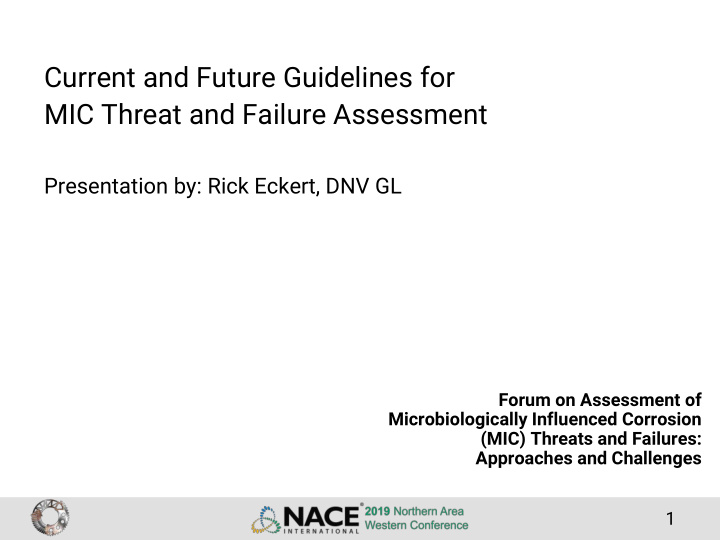



Current and Future Guidelines for MIC Threat and Failure Assessment Presentation by: Rick Eckert, DNV GL Forum on Assessment of Microbiologically Influenced Corrosion (MIC) Threats and Failures: Approaches and Challenges 1
Sources of Guidelines Industry consensus standards and test methods (e.g., NACE, ASTM) • No current standards provide a step-by-step procedure for MIC threat or forensic analysis • CSA Z662 identifies only high level requirements for incident investigation; similar in US Federal Codes Sources of “ Guidance ” • Technical publications • Research • Models • Industry “best practice” and case studies 2
Standards • API • RP 38 “Recommended Practice for Biological Analysis of Subsurface Injection Waters” (1975) • Discontinued • Evolved into TM0194 • NACE TM0194 “Field Monitoring of Bacterial Growth in Oil and Gas Systems” • Neither standard is specific to MIC, but provided early guidance to industry on microbiological culture methods and sampling 3
Standards • ASTM • ASTM G161- 00, “ Standard Guide for Corrosion-Related Failure Analysis” – High Level, not specific to microbiology; checklist • NACE • TM0212- 2018, “Detection, Testing and Evaluation of Microbiologically Influenced Corrosion on Internal Surfaces of Pipelines” • TM0106- 2016, “Detection, Testing and Evaluation of Microbiologically Influenced Corrosion on External Surfaces of Pipelines” • Both provide methods and their application to MIC threat and forensic assessment, but no specific process is given 4
Research • Gas Research Institute • 1988, Field Guide for Investigating MIC • First attempt to integrate bacteria culture testing with chemical composition at corrosion sites • Led to some over-reliance on morphology • Still available (revised) from GTI • PRCI, NOVA, SwRI, UT Knoxville, Montana State University - Center for Biofilm Engineering, University of Calgary, etc. 5
Technical Publications An accurate diagnosis of MIC requires the following: 1) A sample of the corrosion product or affected surface that has not been altered by collection or storage 2) Identification of a corrosion mechanism that is consistent with the vulnerabilities of the material being examined 3) Identification of microorganisms capable of growth and maintenance of the corrosion mechanism in the particular environment 4) Demonstration of an association of the microorganisms with the observed corrosion. “The objective is to have independent types of measurements that are consistent with a mechanism for MIC.” B. Little, J. Lee, R. Ray, “Diagnosing Microbiologically Influenced Corrosion: A State -of-the- Art Review”, Corrosion, Vol 62, No . 11, Nov. 2006 2017 - J. Lee and B. Little, “Diagnosing Microbiologically Influenced Corrosion” in “Microbiologically Influenced Corrosion in the Upstream Oil & Gas Industry”, (eds. T.L. Skovhus, J. Lee, and D. Enning), Boca Raton, FL: CRC Press 2017. 6
Future of MIC Diagnosis - Multiple Lines of Evidence Chemical Environment Materials and MIC Physical Corrosion Diagnosis Conditions Products Microbiology Data generated using molecular methods 7
Future Guidelines Genome Canada MIC Project - Improved molecular microbiological methods for detection and measurement - Models showing the relationship between parameters - Improved sampling/preservation protocols Failure Analysis Guidelines for MIC 8
Thank you. 9
Recommend
More recommend